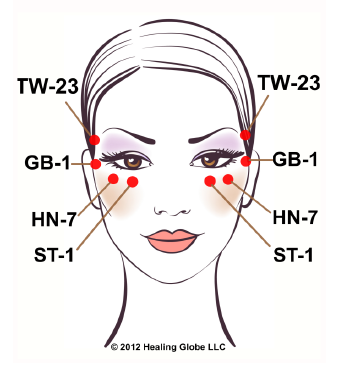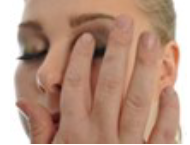Over the past years, there has been a marked increase in the number of people who wear glasses and contact lenses. This can be put down to drastically increased computer usage both at home and at work, and increased TV watching. Good news for opticians around the world – bad news for us. I hear complaints about the eyes related problems almost daily, some people have the dry eyes and must use the eye drops daily, others have excess fluid in the eyes which creates fuzzy vision and difficulties reading. This article provides techniques that help improve the health of your eyes and prevent developing eye-related illnesses.
Your eyes need regular exercise and supply of energy in order to be healthy, just like any other muscle in the body. Your eyes may eventually give up on you and you will need glasses or contact lenses. This doesn’t have to be the case if you regularly take care of your eyes. In this article, I will show you how you can care for your eyes naturally so you can have great vision at any age.
If you start wearing glasses or contact lenses your eyesight will only get worse over time rather than get better as your eyes will get used to the new lenses and need even stronger lenses to function properly. Everybody who wears glasses and contacts will tell you their eyes have grad u-ally got worse over time.
Conditions such as Chronic Dry Eyes, optic neuritis, glaucoma are often associated with chronic health problems. The imbalance in the body can manifest in the eyes, just as the health of the eyes is frequently an indicator of the illness or imbalance in the particular organ or other location in the body.
Puffiness and Dark Circles?
Puffiness in the eye area is either caused by a pool of liquid or a pool of mucus both of which are caused by issues with the kidneys. The type caused by pools of liquid is often caused by excessive liquid intake overworking the kidneys with frequent urination, leading to inflammation.
The second type, caused by accumulation of mucus and fat directly correlates to built-up mucus and fat in and around the kidneys and other organs in that region of the body. The consumption of mucus and fat-containing foods such as dairy products, meat, poultry, sugar, refined grains, and oils. Reducing or eliminating these foods from one’s diet will not only reduce or eliminate puffy eyelids and eye bags but will also correct the internal cause. Regular detoxification efforts will also be beneficial.
Dark Circles under the eyes typically indicate the problems or disorders with the kidneys, and adrenal and gonad hormones. These problems can stem from issues with reproductive or excretory functions which are often caused by the excessive consumption of salty, roasted, baked, or dried foods. A yellowish tone in the eye area is directly related to an over-functioning liver and gallbladder.
A gray discoloration can not only indicate an issue with the kidneys, but also with the lungs, endocrine and lymph systems, and reproductive system. These issues can be caused by excessive ingestion of yang foods such as salt, dairy, animal fats, and meat. It can also indicate a lack of oxygen in the body and is often present with smokers.
Poor Eye Health Indicates Dysfunction in Organs
My approach to treating eye related problems is to correct the underlined energy systems that support the eyes and to promote the blood circulation to the eyes. I have used these techniques on myself and my clients for many years to correct a wide range of eye problems. If your notice that your vision suddenly gets worse, it can be energetically related to the dysfunction in the Kidney, Liver, or Stomach meridians.
Holding Acupressure Sedating, Strengthening and Control points for Kidney, Liver, or Stomach meridians helps to balance many eye related issues. Your energy medicine practitioner can determine if these meridians are over or under energized and balance them.
When you are treated for an eye condition with using the methods described here, any underlying imbalances that are attributing to your symptoms will be reduced. These techniques can be helpful in treating the following conditions:
- Glaucoma
- Floaters
- Cataracts
- Eye Allergies
- Macular Degeneration Optic Atrophy
- Night Blindness
- Chronic Dry Eyes
- Tired or Twitching Eyes Bad Night Vision
- Circles Under Eyes
Natural Ways to Improve Eye Health
There are many Acupuncture Points located around the eyes that promote eye health. These points bring energy and blood to the eyes and allow nourishing the tissue around the eyes.
Visual information from the eyes is processed in the occipital area of the brain, located in the back of the head. Bladder meridian passes through the eyes as well as the occipital (back) part of the brain. Activating points of the Bladder meridian is very effective in relieving the painful symptoms. These points are located on both sides of the face. Apply a deep pressure with thumbs, index, or middle fingers of both hands for 2-4 minutes:
 Bladder 1 (BL-1) – This point is located in the inner corner of each eye. This point brings energy and blood to the eyes and can be used to treat eye pain as well as other eye related illnesses such as glaucoma, night blindness, early-stage cataracts, conjunctivitis and blurred vision.
Bladder 1 (BL-1) – This point is located in the inner corner of each eye. This point brings energy and blood to the eyes and can be used to treat eye pain as well as other eye related illnesses such as glaucoma, night blindness, early-stage cataracts, conjunctivitis and blurred vision.
Bladder 2 (BL-2) – This point is located at the inner end of the eyebrow. Some of the indications to use this point include twitching of the eyelids, glaucoma, frontal headache, blurring or failing of vision, excessive tearing, redness, swelling, pain of the eyes, dimness of vision, visual dizziness, night blindness, headache following alcohol intoxication, and color blindness.
HN-4 – Located in the hollow at the midpoint of the eyebrow, directly above the pupil. It is used for eye strain, acute conjunctivitis, cloudiness of the cornea, frontal headache, floaters, myopia, redness, visual obstruction, swelling and pain of the eyes, twitching of the eyelids, and ptosis.
Triple Warmer 23 (TW-23) – The Triple Warmer 23 located in the hollow at the outside end of the eyebrows. This point is used for all eye and facial problems including headaches, redness and pain of the eye, blurring of vision, twitching of the eyelids, Optic nerve atrophy, and blurred vision.
 Gall Bladder 1 (GB-1) – Located on the outside corner of the eye. This point is used to brighten the eyes as well as for headaches, redness and pain of the eyes, failing or blurring of vision, photophobia, dry, itchy eyes, early-stage cataracts, and conjunctivitis.
Gall Bladder 1 (GB-1) – Located on the outside corner of the eye. This point is used to brighten the eyes as well as for headaches, redness and pain of the eyes, failing or blurring of vision, photophobia, dry, itchy eyes, early-stage cataracts, and conjunctivitis.
HN-7 – Located below the eye, approximately one-fourth the distance from the outer to the center side of the eye. Used for all types of eye diseases, inflammation of the optic nerve, atrophy of the optic nerve, glaucoma, nearsightedness, and macular degeneration.
Stomach 1 (ST 1) – With the eyes looking straight forward, this point is located directly below the pupil, between the eyeball and the eye socket. This is the main point for all eye problems, conjunctivitis, night blindness, facial paralysis, and excessive tearing.
Exercises To Strengthen Eye Muscles
Blinking
Blinking is an often overlooked yet simple way to keep your eyes fresh and being able to focus longer. Computer users and television watchers tend to blink less, especially when they are intently focused on something.
After you have done this for two minutes, mentally take note of how your eyes feel, are they strained, relaxed, tired.
Whenever you blink your eyes are going into a brief period of darkness which helps to keep your eyes fresh and discharges previous information. This also helps to reduce eye strain.
Palming
Palming is done to relieve stress around the eyes and as a way to relax your eyes while taking a break. It gives you the opportunity to rest your mind and your eyes for a few minutes at a time. Palming
brings increased flow of energy to your eyes and balances the brain circuits that receive visual stimuli
- Make yourself comfortable whilst leaning forward on a desk or with your elbows resting on your knees. Close your eyes.
- Place your two palms over your eyes, your fingers on your forehead and the heel of your hands resting on your cheekbones.
- If possible, extend your thumbs to cover the temples. Cross the baby fingers over the 3rd eye or cross one hand over the other.
Tracing Figure 8
 This is to exercise your eye muscles and increase their flexibility.
This is to exercise your eye muscles and increase their flexibility.
- Imagine a giant horizontal figure of eight in front of you about 10 feet in front of you and mentally turn it on its side.
- Trace it one way for a few minutes and then the other way for a few minutes.
- Try figure-8-ting both eyes with fingers of one hand using a ‘Metabolizing 8’ that meets at the center. This helps the eyes to metabolize light, stimulation, and stress as well as increases coordination and communication between the eyes and the brain.
Taping
 Tap your eyelids to brings energies into motion and resets the eye’s signaling to the brain.
Tap your eyelids to brings energies into motion and resets the eye’s signaling to the brain.
- Lay the finger over an eye and gently tap on that finger with the other hand.
- Do the same on the other eye.
This helps with eye fatigue. You may also tap along the sutures of the skull and all over the scalp and temples to help release the muscles that support the eyes. End by pulling the ears.
Zooming
- Sit in a comfortable position.
- Stretch out your arm and extend your thumb out.
- Focus on your thumb as your arm is outstretched.
- Bring your thumb closer to you, focusing all the time, until your thumb is about 3 inches in front of your face.
- Move your thumb away again until your arm is fully outstretched.
Do this for a few minutes at a time.
Essential Nutrients For Your Eyes
Lutein and Zeaxanthin
Lutein and Zeaxanthin compounds are carotenoids related to beta-carotene. They are both found in large quantities in the lens and retina of the eyes. Their function is to protect the eyes from damage caused by free radicals, which can interact with and break down healthy tissue. Lutein and Zeaxanthin help protect the eyes by filtering high-energy blue light protecting underlying cell layers from potential light damage. Lutein and Zeaxanthin are found in yellow and orange fruits & vegetables, dark green, leafy vegetables and egg yolks.
Alpha Lipoic Acid
Alpha Lipoic Acid increases glutathione levels in the body. It is a naturally produced antioxidant that protects against cataracts in the eye and helps dissolve toxic substances in the liver.
Vitamins
Vitamin A helps prevent night blindness, stops the formation of cataracts, and may prevent blindness from macular degeneration.
Vitamin C helps the eye’s production of aqueous humor and the reformation of the cornea. It also helps to reduce the risk of cataracts.
Vitamin E is a powerful antioxidant shown to prevent cataracts and helps prevent macular degeneration.
Vitamin B12 helps the eye shield protein in the lens.
Download my free “Weight Loss Breakfast Recipe Book for Beautiful and Slim Body“. These recipes are packed with special fat burning and protein-rich nutrients that help to lose weight, lower your blood sugar and keep your energy levels steady throughout the day.
Whether you have diabetes, autoimmune illness, or just want to eat better and have fewer cravings and binges, start your morning with these nutritious, delicious, and satisfying meals.

Irina Maryanchik, EHH-MA, EEM-CP, PLT


 Bladder 1 (BL-1) – This point is located in the inner corner of each eye. This point brings energy and blood to the eyes and can be used to treat eye pain as well as other eye related illnesses such as glaucoma, night blindness, early-stage cataracts, conjunctivitis and blurred vision.
Bladder 1 (BL-1) – This point is located in the inner corner of each eye. This point brings energy and blood to the eyes and can be used to treat eye pain as well as other eye related illnesses such as glaucoma, night blindness, early-stage cataracts, conjunctivitis and blurred vision. Gall Bladder 1 (GB-1) – Located on the outside corner of the eye. This point is used to brighten the eyes as well as for headaches, redness and pain of the eyes, failing or blurring of vision, photophobia, dry, itchy eyes, early-stage cataracts, and conjunctivitis.
Gall Bladder 1 (GB-1) – Located on the outside corner of the eye. This point is used to brighten the eyes as well as for headaches, redness and pain of the eyes, failing or blurring of vision, photophobia, dry, itchy eyes, early-stage cataracts, and conjunctivitis. This is to exercise your eye muscles and increase their flexibility.
This is to exercise your eye muscles and increase their flexibility. Tap your eyelids to brings energies into motion and resets the eye’s signaling to the brain.
Tap your eyelids to brings energies into motion and resets the eye’s signaling to the brain.